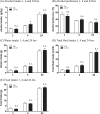An amylin analogue attenuates alcohol-related behaviours in various animal models of alcohol use disorder
- PMID: 30710109
- PMCID: PMC6461824
- DOI: 10.1038/s41386-019-0323-x
An amylin analogue attenuates alcohol-related behaviours in various animal models of alcohol use disorder
Abstract
Recent findings have identified salmon calcitonin (sCT), an amylin receptor agonist and analogue of endogenous amylin, as a potential regulator of alcohol-induced activation of the mesolimbic dopamine system and alcohol consumption. Providing that the role of amylin signalling in alcohol-related behaviours remains unknown, the present experiments investigate the effect of sCT on these behaviours and the mechanisms involved. We showed that repeated sCT administration decreased alcohol and food intake in outbred rats. Moreover, single administration of the potent amylin receptor antagonist, AC187, increased short-term alcohol intake in outbred alcohol-consuming rats, but did not affect food intake. Acute administration of sCT prevented relapse-like drinking in the "alcohol deprivation effect" model in outbred alcohol-experienced rats. Additionally, acute sCT administration reduced operant oral alcohol self-administration (under the fixed ratio 4 schedule of reinforcement) in selectively bred Sardinian alcohol-preferring rats, while it did not alter operant self-administration (under the progressive ratio schedule of reinforcement) of a highly palatable chocolate-flavoured beverage in outbred rats. Lastly, we identified differential amylin receptor expression in high compared to low alcohol-consuming rats, as reflected by decreased calcitonin receptor and increased receptor activity modifying protein 1 expression in the nucleus accumbens (NAc) of high consumers. Collectively, our data suggest that amylin signalling, especially in the NAc, may contribute to reduction of various alcohol-related behaviours.
Figures





Similar articles
-
Effects of sub-chronic amylin receptor activation on alcohol-induced locomotor stimulation and monoamine levels in mice.Psychopharmacology (Berl). 2020 Nov;237(11):3249-3257. doi: 10.1007/s00213-020-05607-8. Epub 2020 Jul 10. Psychopharmacology (Berl). 2020. PMID: 32651639 Free PMC article.
-
Activation of amylin receptors attenuates alcohol-mediated behaviours in rodents.Addict Biol. 2019 May;24(3):388-402. doi: 10.1111/adb.12603. Epub 2018 Feb 6. Addict Biol. 2019. PMID: 29405517 Free PMC article.
-
Effects of a selective long-acting amylin receptor agonist on alcohol consumption, food intake and body weight in male and female rats.Addict Biol. 2021 Mar;26(2):e12910. doi: 10.1111/adb.12910. Epub 2020 May 8. Addict Biol. 2021. PMID: 32383257
-
Receptor pharmacology.Adv Pharmacol. 2005;52:47-65. doi: 10.1016/S1054-3589(05)52003-9. Adv Pharmacol. 2005. PMID: 16492540 Review.
-
Central control of energy balance by amylin and calcitonin receptor agonists and their potential for treatment of metabolic diseases.Basic Clin Pharmacol Toxicol. 2020 Sep;127(3):163-177. doi: 10.1111/bcpt.13427. Epub 2020 May 18. Basic Clin Pharmacol Toxicol. 2020. PMID: 32363722 Review.
Cited by
-
Salmon Calcitonin Attenuates Some Behavioural Responses to Nicotine in Male Mice.Front Pharmacol. 2021 Jun 21;12:685631. doi: 10.3389/fphar.2021.685631. eCollection 2021. Front Pharmacol. 2021. PMID: 34234676 Free PMC article.
-
An Overview of Appetite-Regulatory Peptides in Addiction Processes; From Bench to Bed Side.Front Neurosci. 2021 Dec 9;15:774050. doi: 10.3389/fnins.2021.774050. eCollection 2021. Front Neurosci. 2021. PMID: 34955726 Free PMC article.
-
Characterization of Antibodies against Receptor Activity-Modifying Protein 1 (RAMP1): A Cautionary Tale.Int J Mol Sci. 2022 Dec 16;23(24):16035. doi: 10.3390/ijms232416035. Int J Mol Sci. 2022. PMID: 36555690 Free PMC article.
-
Semaglutide reduces alcohol intake and relapse-like drinking in male and female rats.EBioMedicine. 2023 Jul;93:104642. doi: 10.1016/j.ebiom.2023.104642. Epub 2023 Jun 7. EBioMedicine. 2023. PMID: 37295046 Free PMC article.
-
Palatable food access impacts expression of amylin receptor components in the mesocorticolimbic system.Exp Physiol. 2020 Jun;105(6):1012-1024. doi: 10.1113/EP088356. Epub 2020 May 13. Exp Physiol. 2020. PMID: 32306457 Free PMC article.
References
-
- Mack C, Wilson J, Athanacio J, Reynolds J, Laugero K, Guss S, et al. Pharmacological actions of the peptide hormone amylin in the long-term regulation of food intake, food preference, and body weight. Am J Physiol Regul Integr Comp Physiol. 2007;5:R1855–63. doi: 10.1152/ajpregu.00297.2007. - DOI - PubMed
Publication types
MeSH terms
Substances
Grants and funding
LinkOut - more resources
Full Text Sources
Medical
Molecular Biology Databases
Research Materials

